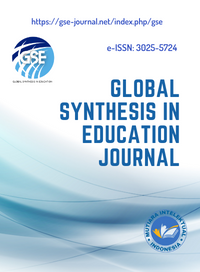Journaling as a Medium for Narrative Discourse Development: A Qualitative Analysis in an Indonesian EFL Setting"
DOI:
https://doi.org/10.61667/sg7tt032Keywords:
journaling , narrative discourse development, indonesian EFL settingAbstract
This qualitative study at Mamina English Course in Batam explored how journaling helps first-grade junior high students improve their English narrative writing. Many students learning English in Indonesia often struggle with vocabulary, grammar, and expressing ideas freely. This research aimed to find more engaging teaching methods. Journaling seemed promising because it's a relaxed way to write, reducing anxiety and encouraging practice. Ten students journaled regularly for a month. Data from surveys and writing tests, informed by key language acquisition theories and teaching approaches, showed positive results. Students reported increased motivation, engagement, creativity, self-expression, and writing confidence. To understand this better, our study gathered detailed information from ten students over one month. We used surveys to hear directly about their experiences and also looked at their writing tests. The ideas behind our study come from important theories about how people learn a second language. For example, Stephen Krashen's Affective Filter Hypothesis suggests that feeling relaxed helps learning, and journaling certainly offers that. Merrill Swain's Output Hypothesis highlights the importance of language production, and journaling offers numerous opportunities for this practice. We also explored the role of motivation in student learning and how Discourse Analysis can reveal students' language usage. On the instructional side, we examined Process Writing, which emphasizes the stages of writing, and Constructivism, which posits that learners actively construct their own understanding. Although the findings do not establish a direct cause-and-effect relationship, they indicate that journaling creates a supportive atmosphere for self-expression and language experimentation. The study underscores the potential of journaling to empower young English learners and advocates for its inclusion in educational curricula, along with suggestions for further research.
References
Abdullah, H., Zain, A. M., Wahab, N. A., Idrus, M. M., & Ahmad, M. R. W. (2020). A process approach in the teaching of writing: Saving 21st-century learners from writer’s block. Universal Journal of Educational Research, 8(1), 1-10. https://doi.org/10.13189/UJER.2020.081283
Adawiyah, R. (2017). An analysis of theme-rheme organization in academic essays written by fifth-semester students of UIN Raden Fatah Palembang. [Skripsi].
Alruwani, M. M., & Susanto, D. A. (2025). Challenges in punctuation usage among Libyan EFL secondary students. English Review: Journal of English Education, 13(1), 397-406.
Ayuningtyas, D., Senowarsito, S., & Susanto, D. A. (2023). Illocutionary Acts in Webtoon “The Masked Fables Season 1”. JOEL: Journal of Educational and Language Research, 2(7), 989-998.
Brahmbhatt, M. (n.d.). Journaling: A powerful academic writing learning tool. English Language and Literature Studies, 2(2), 1-10. https://doi.org/10.58213/ell.v2i2.23
Casanave, C. P. (2011). Journal writing in second language education. Routledge.
Casanave, C. P. (2023). A journal on student, teacher, and researcher journal writing. JALT Journal, 45(1), 7-20. https://doi.org/10.37546/jaltjj45.1-7
Dai, Z., & Liu, J. (2013). Grammar: From experience to language. Theory and Practice in Language Studies, 3(6), 1045-1049. https://doi.org/10.4304/TPLS.3.6.1045-1049
Dart, B. C., Boulton-Lewis, G. M., Brownlee, J. M., & McCrindle, A. R. (1998). Changes in knowledge of learning and teaching through journal writing. Assessment & Evaluation in Higher Education, 23(3), 305-317. https://doi.org/10.1080/0267152980130305
Dias Andris, S. (2023). Investigating Communicative Language Teaching Barriers for English Students in Higher Education.
Dias Andris, S. (2023). students’cognitive language learning strategy in mastering english material at vocational school level.
Dias Andris, S. (2025). Discourse in the ELT Classroom.
Dwivedi, Y. K. (2022). Metaverse beyond the hype: Multidisciplinary perspectives on emerging challenges, opportunities, and agenda for research, practice, and policy. International Journal of Information Management, 66, Article 102442. https://doi.org/10.1016/j.ijinfomgt.2022.102442
Győri, Z. (2025). The input hypothesis. Scribd. Retrieved from https://www.scribd.com/document/284431055/The-Input-Hypothesis
Hayman, B., Wilkes, L. M., & Jackson, D. (2012). Journaling: Identification of challenges and reflection on strategies. Nurse Researcher, 19(3), 27-32. https://doi.org/10.7748/NR2012.04.19.3.27.C9056
Hentihu, I. F., Susanto, D. A., Ambalegin, A., Syamsudin, S., Hulu, F., Indriana, P., ... & Samad, S. (2025). Fluent English with action-based techniques.
Hyland, K. (2016). Academic publishing: Issues and challenges in the construction of knowledge. Oxford University Press. Retrieved from https://books.google.co.id/books?hl=id&lr=&id=j9enCwAAQBAJ&oi=fnd&pg=PA1994&dq=Hyland
Importance of motivation in learning the English language. (2022). Retrieved from https://www.hnjournal.net/ar/3-1-54/
Investigating cognitive-linguistic development in second language acquisition. (2022). In Cognitive-linguistic approaches to second language acquisition (pp. 1-20). https://doi.org/10.4324/9781003155683-2
Jaramillo, N. C., & Vera, K. S. (2021). The influence of the affective filter on the development of oral production in English language learning. Revista de Ciencias de la Educación, 8(2), 1-15. https://doi.org/10.35290/RCUI.V8N2.2021.411
Lantolf, J. P. (2000). Sociocultural theory and second language learning. Oxford University Press.
Mahardhika, B. A., Susanto, D. A., & Siti, N. A. (2023). Analysis of Amir’s defense mechanisms projected upon his bereavement in The Kite Runner. Analysis of Amir’s defense mechanisms projected upon his bereavement in The Kite Runner, 8(1), 1-20.
Miller, L. B. (2017). Review of journaling as a teaching and learning strategy. Teaching and Learning in Nursing, 12(1), 1-5. https://doi.org/10.1016/J.TELN.2016.10.004
Qualitative research in online language learning: What can it do? (2022). In Advances in language and literacy education (pp. 1-20). https://doi.org/10.4018/978-1-6684-7540-9.ch010
Riswalastika, E., Susanto, D. A., & Suwarti, T. S. (2023). Using Pop-Up Book in E-Learning to Improve Students Vocabulary Mastery Student. Edusia: Jurnal Ilmiah Pendidikan Asia, 3(1), 15-27.
Rodliyah, R. S. (2019). Extensive writing activity through journaling: Students’ voices. In Proceedings of the International Conference on Language, Literature, and Education (pp. 1-8). https://doi.org/10.2991/ICOLLITE-18.2019.43
Rohmadi, M., Sudaryanto, M., Susanto, D. A., Saddhono, K., & Saputra, A. D. (2023). Sociopragmatic study of Javanese oral discourse in big city communities as an effort to maintain indigenous language. Research Journal in Advanced Humanities, 4(4), 41-59.
Salsabillah, A. S. K., Sodiq, J., & Susanto, D. A. (2023, March). Mood analysis of little women movie script in contribution for teach ELT classroom. In Proceeding of English Teaching, Literature and Linguistics (Eternal) Conference (Vol. 3, No. 1, pp. 37-45).
Septiana, A. N., Sumardiyani, L., & Susanto, D. A. (2023). Thematic Progression in Jack Ma Speech †œWe Never Give Up†and as an Alternate Source for Teaching Speaking. Allure Journal, 3(2), 106-116.
Sun, W. (2020). The output hypothesis and its implications for language teaching. Journal of Agricultural Engineering Research, 10(1), 1-8. https://doi.org/10.22606/JAER.2020.53005
Susanto, D. A. (2023). Attitudinal messages in the friday sermon on death: appraisal analysis. Eternal (English Teaching Journal), 14(2), 234-244.
Susanto, D. A. (2024). Case Studies And Examples Of Effective English Correspondences. English Correspondences, 105.
Susanto, D. A. (2025). Spoken Discourse and Appraisal in ELT: Exploring Interpersonal Meaning in Classroom Communication. IJELT: Indonesian Journal of Education, Language, and Technology, 1(2), 402-410.
Susanto, D. A., & Bimo, D. S. (2023). Appraisal attitude on editorial news: our disastrous president. NUSRA: Jurnal Penelitian dan Ilmu Pendidikan, 4(3), 380-391.
Susanto, D. A., Bimo, D. S., & Pinandhita, F. (2025). Discourse in the Language Classroom: A Qualitative Exploration of Speaking Competence in SLA Contexts. IJELT: Indonesian Journal of Education, Language, and Technology, 1(2), 154-165.
Susanto, D. A., Egar, N., & Sumardiyani, L. (2023, July). Investigating Indonesian EFL learners’ cognitive language learning strategy within blended learning in the covid-19 pandemic. In Conference on English Language Teaching (pp. 1035-1048).
Susanto, D. A., Elmasari, N., & Bimo, D. S. (2025). Integrating SLA to enhancing bilingual skills in developing vocabulary, speaking, listening and reading through storytelling. IJELT: Indonesian Journal of Education, Language, and Technology, 1(1), 39-54.
Susanto, D. A., Oktavia, M., & Sembiring, L. T. A. B. (2021). Students’ understanding of spoken discourse in the context of English language teaching at university. Eralingua: Jurnal Pendidikan Bahasa Asing dan Sastra, 5(1), 1-12. https://doi.org/10.26858/ERALINGUA.V5I1.18780
The revolutionizing effects of journal writing strategy on students’ writing ability. (2023). Journal of Literature, Languages and Linguistics, 96, 7-15. https://doi.org/10.7176/jlll/96-07
Umam, H. K., Susanto, D. A., & KA, A. P. (2025). Student’s perspective on the implementation of technology (youtube) and memorizing technique to enhance students' speaking ability in riyadul mubarok junior high school Brebes. IJELT: Indonesian Journal of Education, Language, and Technology, 1(1), 55-63.
Wardhani, R. K., & Susanto, D. A. (2023). investigation memory learning strategy used by students’vocational school as english foreign language. PRIMER: Jurnal Ilmiah Multidisiplin, 1(4), 409-419.
Downloads
Published
Issue
Section
License
Copyright (c) 2025 Global Synthesis in Education Journal

This work is licensed under a Creative Commons Attribution-NonCommercial-ShareAlike 4.0 International License.




















